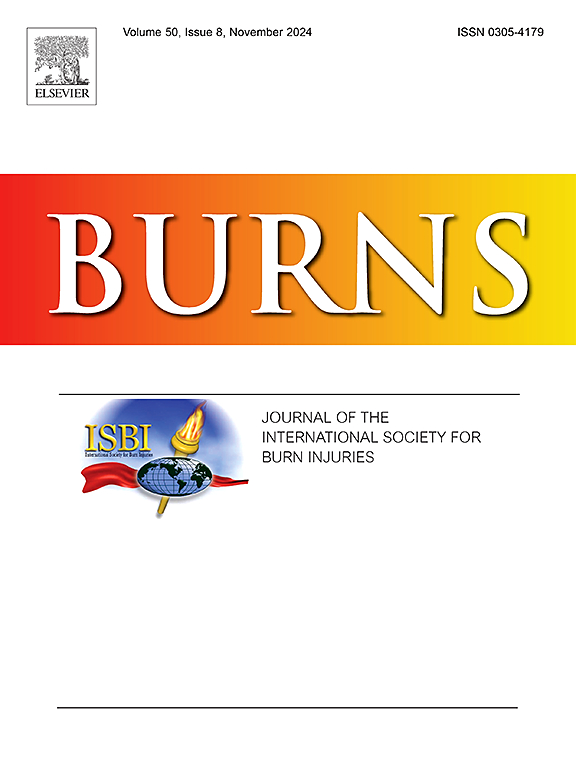From cadaveric donation to cryopreserved total skin allografts: Transforming the Chilean skin donation model
IF 3.2
3区 医学
Q2 CRITICAL CARE MEDICINE
引用次数: 0
Abstract
Background
The clinical utility of skin allografts (SA) is well established. However, the donation and procurement of cadaveric skin—historically the primary source of SA—remain limited in many countries. A skin donation model based on the use of excess surgical tissue from body contouring procedures was introduced and compared with the traditional cadaveric donation model.
Methods
A retrospective review of skin donations in Chile was conducted over two periods (2017–2019 and 2022–2024), analyzing the performance and characteristics of two donation pathways: cadaveric and living donors.
Results
During the first period (2017–2019), four cadaveric donors provided a total of 10,959 cm² of skin. In the second period (2022–2024), 353 donors contributed 153,585 cm² of skin, of which 348 were living donors (131,997 cm²) and five were cadaveric (21,588 cm²).
Conclusions
Initially conceived as a complementary strategy, the living donor model has evolved to become the primary source of skin allografts in Chile. This approach significantly increases the availability of SA, broadens therapeutic indications, and promotes the concept of transforming excess surgical tissue into valuable therapeutic resources. Moreover, it enables the production of cryopreserved full-thickness skin allografts (CTSA), which serve not only as temporary wound coverage but also as dermal regenerative scaffolds, particularly beneficial in the treatment of burns affecting functionally and aesthetically critical areas. This new paradigm supports a more accessible and sustainable culture of skin donation while offering promising benefits for regenerative burn care.
从尸体捐献到冷冻保存的全同种异体皮肤移植:智利皮肤捐献模式的转变
背景:同种异体皮肤移植(SA)的临床应用是公认的。然而,在许多国家,捐献和获取尸体皮肤——历史上sa的主要来源——仍然有限。介绍了一种基于利用人体轮廓术中多余的外科组织的皮肤捐赠模型,并与传统的尸体捐赠模型进行了比较。方法回顾性分析智利2017-2019年和2022-2024年两期皮肤捐献情况,分析尸体和活体捐献两种捐献途径的表现和特点。结果在第一阶段(2017-2019年),4名尸体供体共提供10,959 cm²皮肤。在第二阶段(2022-2024),353人捐献了153,585 cm²的皮肤,其中348人是活体捐献者(131,997 cm²),5人是尸体捐献者(21,588 cm²)。活体供体模型最初被认为是一种补充策略,现已发展成为智利同种异体皮肤移植的主要来源。这种方法显著增加了SA的可用性,拓宽了治疗指征,并促进了将多余手术组织转化为有价值的治疗资源的概念。此外,它能够生产冷冻保存的全层同种异体皮肤移植物(CTSA),它不仅可以作为临时伤口覆盖,还可以作为皮肤再生支架,特别有利于治疗影响功能和美学关键区域的烧伤。这种新模式支持更容易获得和可持续的皮肤捐赠文化,同时为再生烧伤护理提供了有希望的好处。
本文章由计算机程序翻译,如有差异,请以英文原文为准。
求助全文
约1分钟内获得全文
求助全文
来源期刊

Burns
医学-皮肤病学
CiteScore
4.50
自引率
18.50%
发文量
304
审稿时长
72 days
期刊介绍:
Burns aims to foster the exchange of information among all engaged in preventing and treating the effects of burns. The journal focuses on clinical, scientific and social aspects of these injuries and covers the prevention of the injury, the epidemiology of such injuries and all aspects of treatment including development of new techniques and technologies and verification of existing ones. Regular features include clinical and scientific papers, state of the art reviews and descriptions of burn-care in practice.
Topics covered by Burns include: the effects of smoke on man and animals, their tissues and cells; the responses to and treatment of patients and animals with chemical injuries to the skin; the biological and clinical effects of cold injuries; surgical techniques which are, or may be relevant to the treatment of burned patients during the acute or reconstructive phase following injury; well controlled laboratory studies of the effectiveness of anti-microbial agents on infection and new materials on scarring and healing; inflammatory responses to injury, effectiveness of related agents and other compounds used to modify the physiological and cellular responses to the injury; experimental studies of burns and the outcome of burn wound healing; regenerative medicine concerning the skin.
 求助内容:
求助内容: 应助结果提醒方式:
应助结果提醒方式:


